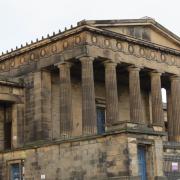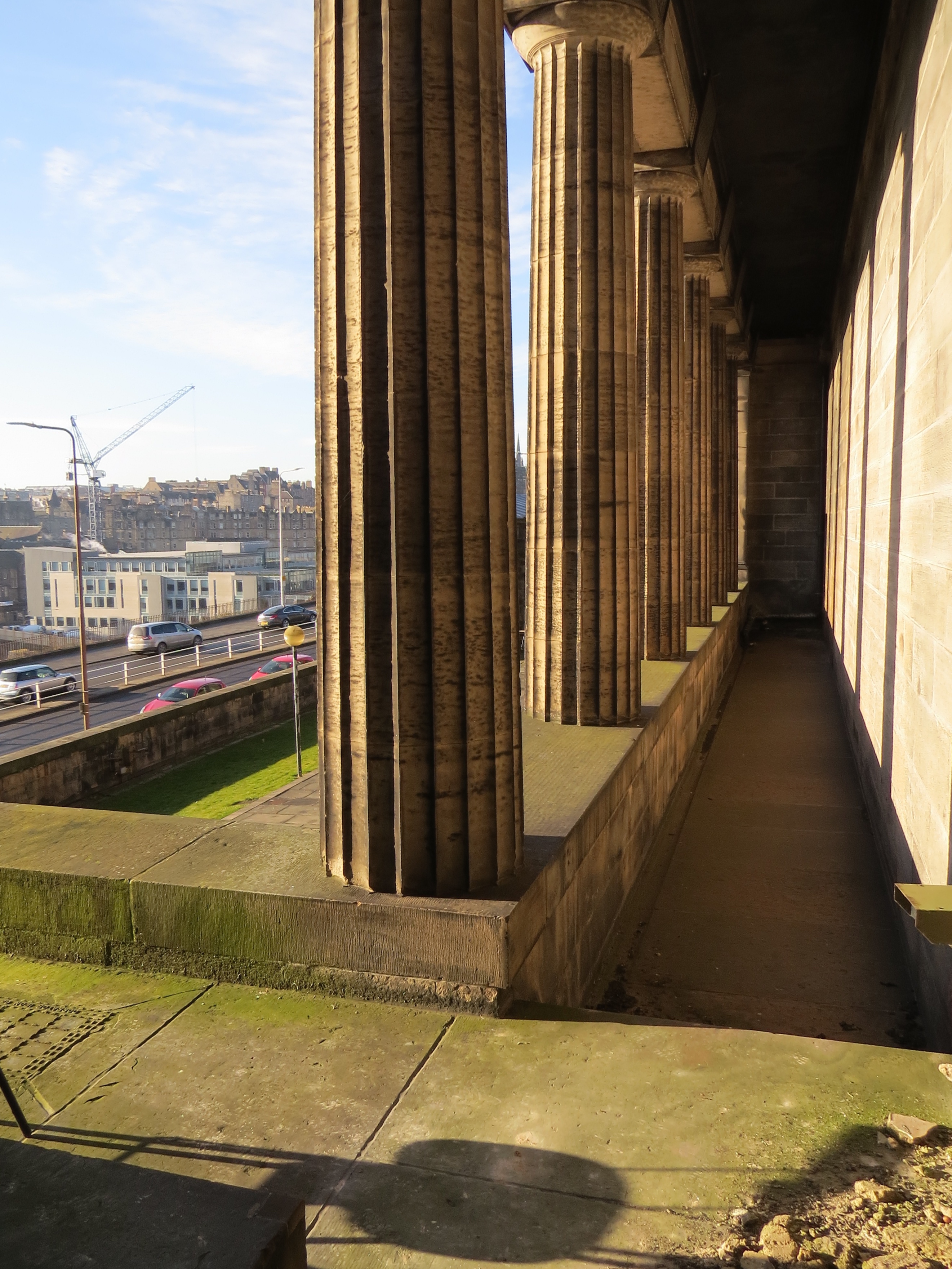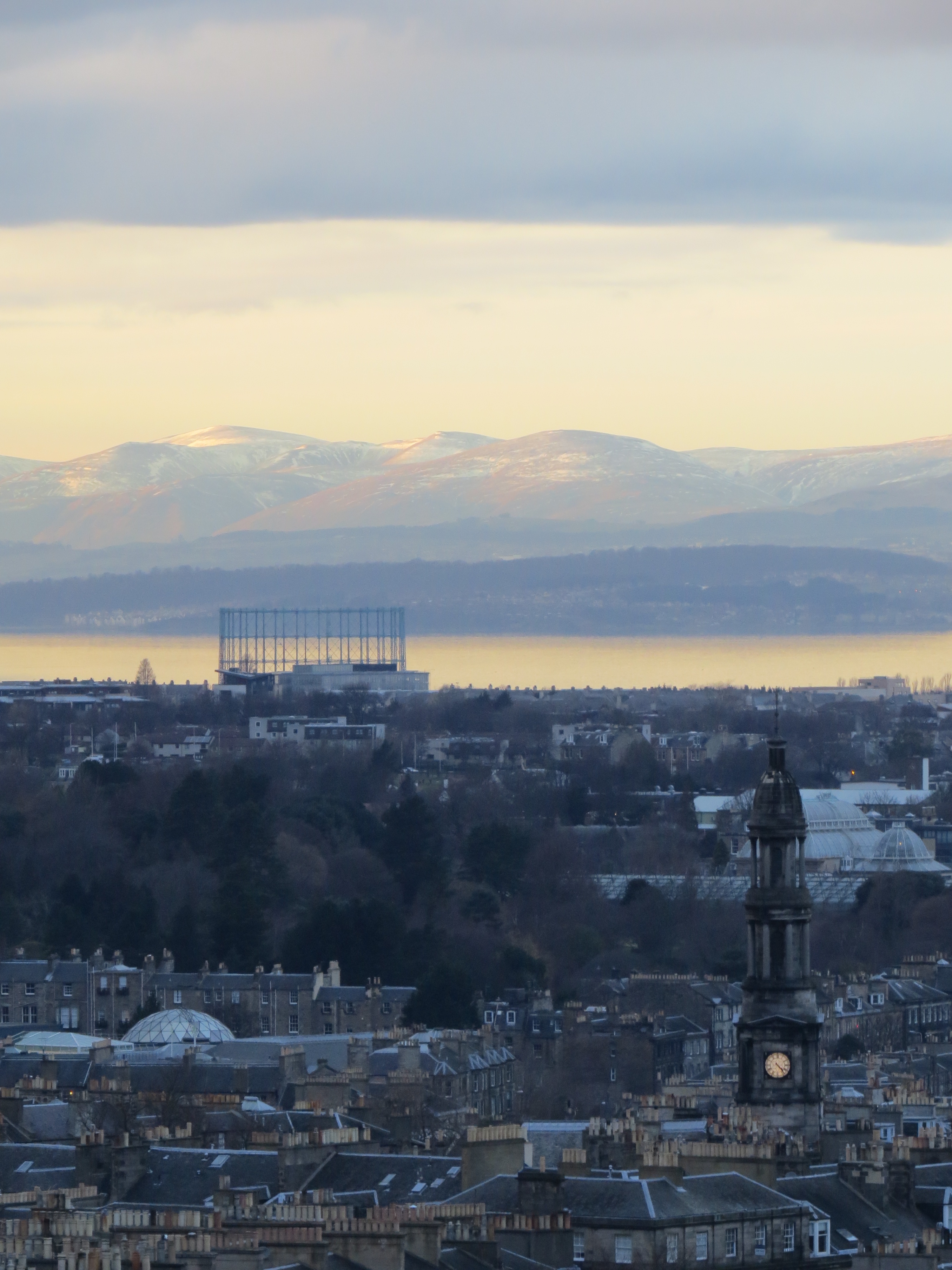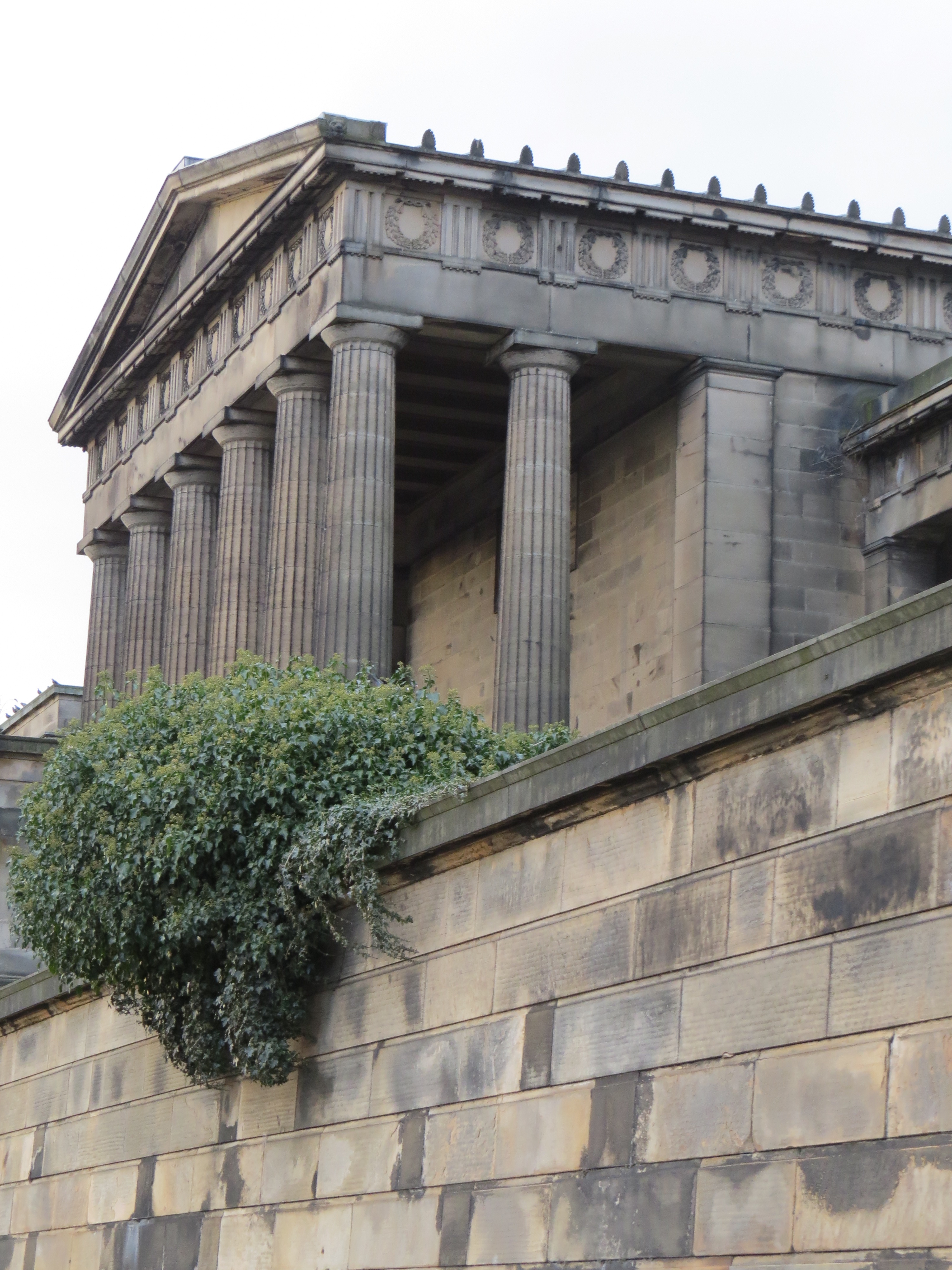
New information has appeared about the existence of a ‘Dark’ Buildings At Risk Register, and the placing on it of the former Royal High School (RHS) premises at 5–7 Regent Road.
City of Edinburgh Council’s position comes across as nonsensical and self-contradictory. Government agency decision making seems to take place at the discretion of individuals and to be hidden from view.
Recap on a disappearance
Two weeks ago, Spurtle revealed how the Category A-listed RHS had been placed on the Buildings at Risk Register (BARR) compiled by the Royal Commission on the Ancient and Historical Monuments of Scotland (RCAHMS) for Historic Scotland (Breaking news, 4.2.14).
They did so following a survey of late 2011/early 2012 because the property was being ‘mothballed’ and was entering a period of vacancy. However, they told us the complex’s At-Risk status had been hidden from the public at the request of the Council (CEC), who argued that the building was wind and watertight, enjoyed 24-hour security, and that any such listing could jeopardise sensitive negotiations with a potential leaseholder.
The arm of the Council with whom these discussions took place was, we now learn, Corporate Property and Built & Natural Heritage (Services for Communities), although RCAHMS has declined to give the names of any individual officer(s) involved.
In reply to an enquiry by Spurtle for more detail about its approach, CEC told us in a statement of 6 February that:
As a result of ongoing negotiations and concerns over the building’s security, a request was made to remove the Royal High school building from the Buildings at Risk Register website. This was agreed by Historic Scotland.
CEC's mention of ‘ongoing negotiations’ refers without explanation to the supposed sensitive lease discussions, but the mention of ‘concerns over the building’s security’ directly contradicts RCAHMS’s recollection that CEC had offered 24-hour security as a reason for not listing the property in public.
Interestingly, CEC’s clarification of 6 February makes no reference to the property having been wind and watertight. This is significant since Spurtle now understands that CEC’s security fears related to potential theft from the site – theft which could have left the buildings in worse condition and more exposed than before.
In other words, of CEC’s three reasons for justifying RHS's removal from the Register, one (lease negotiations) is unexplained and the other two simply don’t stack up.

Earlier this month, Spurtle went back to the Royal Commission on the Ancient and Historical Monuments of Scotland with a list of specific follow-up questions after our first article. We got answers on Friday and a redacted version of that correspondence appears at the foot of this page.
We asked, for example, how any appearance on the At-Risk Register in 2012 would have affected CEC’s lease negotiations. RCAHMS offers no explanation:
The main purpose of the Register is to identify and raise awareness of the existence of Buildings at Risk throughout Scotland and to monitor their condition. The presence of the building on our website should not have an adverse effect on any building’s sale or lease, but we try to work with all owners of Buildings At Risk to allay any fears they may have.We are not party to negotiations regarding the sale or lease of this, or any other, property on the Register.
Certainly, though, the response undermines the third pillar in CEC’s explanation for its request – sensitive ongoing lease negotiations. That line of argument crumbles like so much neglected stonework.
But even if we take all CEC’s original arguments at face value, why has the still vacant, still insecure RHS not been added to the publicly accessible At-Risk Register following the interim conclusion of lease negotiations last April? RCAHMS replied:
The Register is updated according to reliable information in the public domain or updates from owners/local authorities; in the case of the RHS, we have not been advised of a change of ownership/responsibility.
This is logical. CEC's lease agreement with RHS's developers will not be finally signed and sealed unless the latter have planning permission. Neither ownership nor responsibility have changed.
Logical but odd.
Odd because the reasons given above go no way towards explaining how these partially unresolved negotiations might still be spoiled by RHS appearing on the public BARR. Duddingston House Properties Ltd is very aware of the building's deteriorating condition and turns down no opportunity to mention it (Breaking news, 16.1.15). What's more, it has been aware of the smoke-and-mirrors BARR listing for some time:
We [RCAHMS] were contacted for information by parties preparing the current planning application for the RHS, to confirm the buildings’ presence on the Register.
So why has CEC really wanted to conceal the RHS's condition from the wider world? Has it got anything to do with the UNESCO World Heritage Site? Can it be partly that CEC hasn't wanted to be exposed in public as unwilling or incapable of maintaining an architectural 'icon' in its care?

RCAHM's operation of a 'Dark' Register is a cause for concern, partly because the practice conceals important information from the public which the BARR was set up to highlight, and partly because how decisions are reached on this subject is unclear.
From our latest round of questions to RCAHMS, Spurtle learns that 'The decision on whether to keep a BAR off the website is taken by the BARR Project Manager'. Requests requiring such a 'discretionary, case by case assessment' are 'rare in the course of our overall work'.
In other words, it's all a bit vague. Requests come once in a blue moon, managers use their discretion rather than following what we described to them as a 'formal, pre-established set of criteria', and then the public aren't told. Not exactly transparent.
And importanty, the Royal High School is not a one-off on the 'Dark Side':
The Register is under constant update and change but out of the circa 2500 At Risk buildings on the Register we currently have removed 8 sites (including RHS) from the public website, which equates to 14 buildings (of which 4 are at the RHS) following concerns raised by building owners.
So, somewhere in Scotland, a further 10 important, listed buildings are on a hidden Buildings at Risk Register for reasons the public is not allowed to know about. However, as we learned last month, we could find out what those buildings are if we indulged in a game of heritage Battleships and began lobbing guesses at RCAHMS until eventually striking lucky.
This situation is absurd.

RCAHMS have told Spurtle:
Internal discussions to review the private nature of the RHS entries commenced in December 2014. We were contacted for information by parties preparing the current planning application for the RHS, to confirm the buildings’ presence on the Register. In the context of this information being readied to enter the public domain, alongside our own preparations to commence the tri-annual review of A-listed buildings in Edinburgh, this prompted internal discussion about making the BARR entries live on-line.
The results of the overall At Risk survey will be published in due course.
The trouble with keeping cats in bags is that when they're eventually let out, you tend to get scratched. The dealings of CEC and RCAHMS here have only succeeded in making them look furtive, unaccountable and foolish.
This 'Dark' Buildings at Risk Register is, we suspect, largely an attempt not to provide architectural shopping-lists for burglars. Unfortunately, the practice is also open to abuse by neglectful property owners and misunderstanding by a sceptical public. These are strong reasons for it to be dropped.
Got a view? Tell us at spurtle@hotmail.co.uk and @theSpurtle and Facebook
Redacted correspondence between Spurtle and RCAHMS
Received on 13.02.15 from RCAHMS
Dear XXXXX
Thank you for your follow-up email enquiry regarding the Former Royal High School, 5-7 Regent Road, Edinburgh. We have treated your request as a Freedom of Information request. I have copied this response to the Buildings at Risk team who have furnished the information contained in the responses below.
To answer your questions:
What were the precise grounds for adding the Royal High School (RHS) buildings to the Buildings at Risk Register?
The buildings were incorporated for survey during the tri-annual survey of Edinburgh’s A-listed buildings in late 2011-early 2012. The buildings were identified during this survey as being mothballed and entering a period of vacancy whilst a new use for the site was found.
How would an appearance in the Register in 2012 have affected lease negotiations, and why has the property not been added to the public Register now that the lease has been signed?
The main purpose of the Register is to identify and raise awareness of the existence of Buildings at Risk throughout Scotland and to monitor their condition. The presence of the building on our website should not have an adverse effect on any building’s sale or lease, but we try to work with all owners of Buildings At Risk to allay any fears they may have.
We are not party to negotiations regarding the sale or lease of this, or any other, property on the Register. The Register is updated according to reliable information in the public domain or updates from owners/local authorities; in the case of the RHS, we have not been advised of a change of ownership/responsibility.
Which City of Edinburgh Council (CEC) department requested that the former Royal High School buildings (RHS) should not appear on the public Register?
Corporate Property and Built & Natural Heritage (Services for Communities).
Which CEC officer or officers made this request?
This information is withheld under section 38(1)(b) of FOISA, as - in providing individual's names and place of work (above) - we would be providing personal data; the disclosure of which would breach the data protection principles.
How many other ‘At Risk’ buildings in Scotland are registered but – for similar reasons – do not appear as such on the publicly accessible website?
The Register is under constant update and change but out of the circa 2500 At Risk buildings on the Register we currently have removed 8 sites (including RHS) from the public website , which equates to 14 buildings (of which 4 are at the RHS) following concerns raised by building owners.
How common a practice has this been over the last 10 years? Infrequent but discretionary.
Was there a formal, pre-established set of criteria which determined the decision not to publish the Royal High School’s ‘At Risk’ status?
A discretionary case-by-case assessment is made as such requests are rare in the course of our overall work.
If not, who made this decision?
The decision on whether to keep a BAR off the website is taken by the BARR Project Manager.
When will your next inspection of the former Royal High School take place?
Assessment of the RHS will take place during the next tri-annual survey of Edinburgh which is to commence during the current financial year.
When and how will the Buildings at Risk team decide whether or not to publish the results in public?
Internal discussions to review the private nature of the RHS entries commenced in December 2014. We were contacted for information by parties preparing the current planning application for the RHS, to confirm the buildings’ presence on the Register. In the context of this information being readied to enter the public domain, alongside our own preparations to commence the tri-annual review of A-listed buildings in Edinburgh, this prompted internal discussion about making the BARR entries live on-line.
The results of the overall At Risk survey will be published in due course.
Please let me know if you require further clarification or information.
kind regards,
XXXXX
RCAHMS
On 3 February 2015 at 09:29, Broughton Spurtle <spurtle@hotmail.co.uk> wrote:
Dear XXXXX
Thank you for your helpful reply.
I hope you will be able to respond to these follow-up questions straight away, but if you would prefer us to resubmit them in the form of a Freedom of Information request we will be happy to do so. As before, any answers you provide are likely to be quoted or paraphrased in our publication.
1. What were the precise grounds for adding the Royal High School buildings to the Buildings at Risk Register?
2. How would an appearance in the Register in 2012 have affected lease negotiations, and why has the property not been added to the public Register now that the lease has been signed?
3. Which City of Edinburgh Council (CEC) department requested that the former Royal High School buildings (RHS) should not appear on the public Register?
4. Which CEC officer or officers made this request?
5. How many other ‘At Risk’ buildings in Scotland are registered but – for similar reasons – do not appear as such on the publicly accessible website?
6. How common a practice has this been over the last 10 years?
7. Was there a formal, pre-established set of criteria which determined the decision not to publish the Royal High School’s ‘At Risk’ status?
8. If not, who made this decision?
9. When will your next inspection of the former Royal High School take place?
10. When and how will the Buildings at Risk team decide whether or not to publish the results in public?
I expect to post an article on this subject later today, and will try contacting you by phone in a few hours’ time if I have not already heard from you by email.
In the meantime, thanks again for your cooperation.
Yours sincerely
XXXXX
Editor